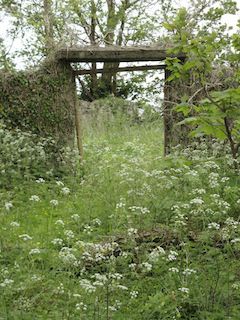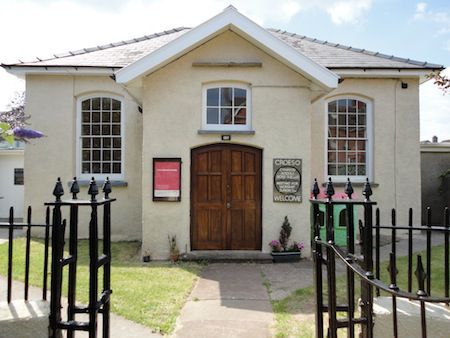The Quakers in Pembrokeshire
Page added 22nd March 2016

Quaker burial grounds near Sutton
When I first visited it about fifteen years ago, it was because I had been told about it; it certainly isn’t a location that you happen upon by accident. It’s close to the village of Sutton, a few miles from Haverfordwest and at the entrance there is a sign that indicates that it dates from 1661.
There aren’t many places that have had relatively consistent usage over such a period that can boast that. But then this place and the people associated with it don’t boast about anything. They are extremely modest, quiet and unassuming. They are the Quakers (Religious Society of Friends) and this is their burial ground – or was, it hasn’t been used for quite a while.
Fifteen years ago, the beautiful, long, tree lined avenue that takes you to the walled burial ground was well maintained but now, like so many cemeteries, it has become neglected and doesn’t quite hold the magic that the entrance suggests.
The Quakers have a long and respected history. The date on the burial ground is significant in that they only emerged as a group after the tumultuous period of the English Civil War in the 1640s and just twenty years later they were sufficiently well established in Pembrokeshire to require a burial ground.
Part of this came about as a result of a visit by George Fox, founder of the movement, to Pembrokeshire in 1657. In his journal, he relates how one of his companions was jailed in Tenby for wearing his hat in church, although by the time Fox had finished talking to him, the governor of the jail had invited Fox to dinner. In Haverfordwest he tells of a ‘great meeting’ following which ‘a great many were settled in the new covenant.’
Persecution had already started but just a few years later, in 1662, began the Acts of Parliament that made life extremely difficult for Non Conformity in general but perhaps especially for the Quakers in that they refused to swear an oath of allegiance to the king or pay tithes.
‘The History of Quakers in Pembrokeshire’ by Stephen Griffith reveals that over the next thirty years not a day passed without the presence of a Quaker in the prison at Haverfordwest.
As a result of the persecution and grim punishment, many Quakers sought safety in going to the new colony of North America. Pennsylvania is named after William Penn, a leading Quaker who arrived there in 1682. The huge area that constitutes the State was given to Penn by Charles II in lieu of an enormous debt.
But the irony is that the Quakers returned to Pembrokeshire with the establishment of Milford as a town, port and whaling station in the late eighteenth century.

Quaker's Meeting House, Milford Haven
As the presence of the Society of Friends in Milford increased, to the point of a new Meeting House (they were never called chapels) being built in 1811, so its long difficult existence in Haverfordwest came to an end; in 1835 the Meeting House at the bottom of High Street was sold and the site used for the construction of The Shire Hall.
Many leading historical figures of the communities of both Milford and Haverfordwest can be glimpsed as belonging to the Society through the centuries – Starbuck and Bateman to name but a few, but in the last century Waldo Williams, leading 20th century Welsh poet, became a Quaker. Waldo went to jail for refusing to pay his taxes, a proportion of which he argued, was being used to promote war. (There’s much more to be said on Waldo that will have to be in another article).
As a teenager, (I’m not saying when that was, but it was quite a while ago) my late father and his business partner, both builders, were engaged by the Society of Friends to renovate part of the Meeting House in Priory Road in Milford. And so for one glorious summer holiday I mixed cement and shovelled hardcore into and around the quaint, old building.